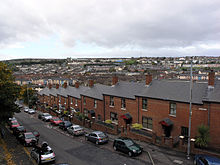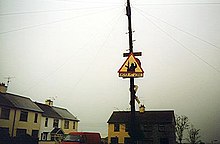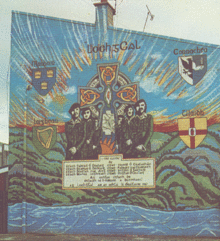Provisional Irish Republican Army
The so-called Provisional Irish Republican Army (German: Provisorische Irisch-Republikanische Armee), in its proper name simply Irish Republican Army, or IRA, or Óglaigh na hÉireann (Irish for Volunteers of Ireland) was an organisation in the Republic of Ireland and the United Kingdom of Great Britain and Northern Ireland. In Ireland it was classified as an Irish Republican paramilitary organisation, while in the United Kingdom it was classified as a terrorist organisation.
It saw itself as the direct and only legitimate continuation of the Irish Republican Army (the Army of the Irish Republic of 1916/1919-1922), which fought for Irish independence in the Easter Rising of 1916 and the Irish War of Independence of 1919-1921.
The Provisional IRA was formed at the turn of 1969/70 at the beginning of the Northern Ireland conflict following a political-ideological split from the older Irish Republican Army, which emerged in 1922 after the War of Independence and fought in the Irish Civil War (1922-1923), among others, by Seán Mac Stíofáin, Ruairí Ó Brádaigh, Dáithí Ó Conaill, Joe Cahill, Billy McKee, Seamus Twomey and others. The group was dissatisfied with the reformist Marxist leadership in Dublin, which seemed to prefer constitutional politics to armed struggle, as well as betraying other essential Irish republican principles for short-term political gain.
For its main goal of an independent, united Ireland, it primarily used terrorist methods such as assassinations, bombings, hostage-taking and robberies to destroy the political system and the internal constitution of Northern Ireland as an integral part of British territory. Other objectives were to protect the Catholic nationalist minority from the Protestant unionist majority and from the British security forces in Northern Ireland. In the course of the Northern Ireland conflict, it killed about 1700 people in Northern Ireland, Great Britain, the Republic of Ireland and mainland Western Europe in the process. In contrast, about 300 of its own members were killed. It was politically supported by its affiliated party Sinn Féin and support groups at home and abroad, such as NORAID.
In 1997, after almost thirty years of fighting, the IRA announced a final ceasefire without having achieved its main goal of Irish reunification, whereupon the Good Friday Agreement was agreed by the parties to the conflict on 10 April 1998. On 28 July 2005, seven years later, the IRA leadership declared an end to the armed struggle: 'All IRA units have been instructed to surrender their weapons. All IRA activists have been instructed to support the development of purely political and democratic initiatives through exclusively peaceful means. IRA activists are not to take part in any other type of action." This was followed by their complete disarmament or destruction of their entire arsenal and in 2007 the recognition of the renamed Northern Ireland Police PSNI.
IRA members and other Irish republicans who did not agree with this development founded new militant groups, the so-called Continuity Irish Republican Army and Real Irish Republican Army (since 2012 New Irish Republican Army), which to this day continue the armed struggle and thus terrorist methods for a united Ireland.
Foundation 1969
The original IRA tried to reorient itself after the unsuccessful Border Campaign of the 1950s. Strong influence was now gained by leftist forces who wanted to give the organization a distinctly Marxist character. Instead of armed struggle, they saw the future in political struggle and the reconciliation of Catholic and Protestant labour. The dramatically escalating unrest of the 1960s in Northern Ireland took the IRA by surprise; as an armed movement it barely existed at the time. It was now at a crossroads: should it join the civil rights movement and work politically for equal rights for Catholics in Northern Ireland, or take up armed struggle against British and Irish Unionist domination? Many urged violent action in the style of guerrilla warfare; in particular, members with a traditional Catholic nationalist background were deeply suspicious of the Marxist ideology of those advocating a political settlement. The eventual rupture was over the question of whether Sinn Féin, as a political organization, should abstain from the party systems in Northern Ireland and in the Irish Republic, both of which were considered equally illegitimate by lineal republicans.
The real cause, however, was the passive attitude of the Dublin leadership during the Northern Ireland Troubles in the summer of 1969, when Catholic republican neighbourhoods, particularly in Belfast and Derry, were attacked by Protestant Unionist militias. Many republicans in Northern Ireland felt that the Marxist IRA had let the Catholic community down in the process, failing to prevent the attacks on Catholic streets and the burning of their homes by loyalists. The traditionalists and militarists accused the IRA leadership in Dublin of failing to bring in weapons, planning or personnel to defend the Catholic streets because of its purely political strategy. In addition, the British government had now sent soldiers to Northern Ireland for the first time in decades to protect Catholics, which the nationalist traditionalists in the IRA saw as an intolerable provocation that required a violent response. Marxists within the IRA's left wing, on the other hand, argued that the tensions between Protestants and Catholics had been deliberately provoked in order to pit workers of both denominations against each other. Violence was therefore only counterproductive to resolving the Northern Ireland conflict.
In December 1969, the IRA therefore split. The more nationalist-minded and violent wing founded the Provisional IRA (short: Provos), so named in allusion to the declaration of the provisional government of the Easter Rising 1916. The goal and task of this grouping was from the beginning the armed guerrilla struggle. The more politically oriented left wing established the Official IRA, from which another actionist-oriented group, the Irish National Liberation Army (INLA), split off in 1974. Although there was also a political split between Provisional Sinn Féin and Official Sinn Féin (later Sinn Féin Workers Party or just Workers Party), politics played no role in the formative years of the Provos.
From the outset, there were feuds between the Provos and the Official IRA, as both factions vied for control of Catholic Nationalist areas, particularly in Belfast. However, the Provos quickly gained the upper hand due to their profiling as the more reliable defenders of the Catholic community.

1969 Target of unionist attacks: Catholic Bogside neighbourhood in Derry (2005)
Organization
The IRA is organised hierarchically. At the top of the organisation is the IRA Army Council, chaired by the IRA Chief of Staff.
Leadership
All units of the IRA are entitled to send delegates to the IRA General Army Convention (GAC). This body is the supreme authority of the organization. Prior to 1969, the GACs met regularly. Because of the difficulties of an illegal organization in keeping a meeting of so many members secret, there have only been a total of three meetings since 1969 (1970, 1986, and 1997).
The GAC elects the twelve-person IRA Executive, nominally the government of the Irish Republic in 1916. The Executive in turn elects the seven members who form the IRA Army Council. This is the actual power centre of the organisation, which determines the political course of action and the basic strategic decisions, as well as appointing the supreme commander, the Chief of Staff, from its ranks or from outside the Army Council.
The Chief of Staff then designates his deputy, the IRA Adjutant General, and staffs a headquarters (IRA General Headquarters; also GHQ) consisting of a number of individual departments. These departments are:
- IRA Quartermaster General (Quartermaster)
- IRA England Department (Actions in England)
- IRA Overseas Department (actions in Western Europe)
- IRA Department of Finance (Finance)
- IRA Department of Engineering (technical development)
- IRA Department of Training
- IRA Department of Intelligence
- IRA Department of Publicity (Public Relations)
- IRA Department of Operations
- IRA Department of Security (internal security service)
Regional command structures
On a regional level, the IRA is divided into a Northern Command, which operated in the nine counties of Ulster as well as the five southern Irish counties on the border, and a Southern Command, which was active in the rest of Ireland. The Provisional IRA was initially commanded by an army council in Dublin. However, in 1977, in parallel with the introduction of the cell structure at local level, command of the "War Zone" was transferred to the Northern Command. This reorganisation, according to journalist and author Ed Moloney, was the idea of Ivor Bell, Gerry Adams and Brian Keenan.
The IRA Southern Command consisted of the Dublin Brigade and a number of smaller units in rural areas. These were mainly tasked with storing and importing weapons for the northern units, as well as raising money through bank robbery and the like. There were also organised units in Britain, Western Europe and the United States.
Brigades
The IRA refers to its ordinary members as volunteers, or óglaigh in Irish. Until the late 1970s, IRA volunteers were organized into units based on conventional military structures. Volunteers living in an area formed a company, which was usually part of a battalion. This in turn could be part of a brigade, although many battalions were not assigned to a brigade.
For most of its existence, the IRA had five areas of brigades for what it termed its "war zone". These brigades were "based" in Belfast, Derry, Tyrone/Monaghan and Armagh. The Belfast Brigade had three battalions, more specifically in the west, north and east of the city. In the early years of the Northern Ireland conflict, the IRA was rapidly developing in Belfast. In August 1969 the Belfast Brigade had only 50 active members. By the end of 1971 it had 1200 members; these gave it a large structure but also one that was harder to control. Derry City had one battalion and southern County Londonderry a second. The Derry City Battalion became the Derry Brigade in 1972 due to a rapid increase in membership following Bloody Sunday (British paratroopers killed 14 unarmed demonstrators during an unsanctioned civil rights march). County Armagh had three battalions. There were two very active battalions in South Armagh, forming the South Armagh Brigade, and a discrete less effective unit in North Armagh. The Tyrone/Monaghan Brigade, which also operated on both sides of the border, and is often just called the East Tyrone Brigade, also frequently controlled units from County Londonderry and North Armagh. Fermanagh, South Down and North Antrim had units that were not attached to any brigade or battalion. The command structures at battalion and company level were the same: Both had their own commanders, quartermasters, and officers in charge of explosives and reconnaissance. Sometimes there were also those responsible for training or finance.
The 1980s saw a significant increase in the number of informants in the IRA. Units in Derry and Belfast were particularly affected. While the Belfast Brigade was the most active of the four brigades in the 1970s, this changed in the 1980s and 1990s. Thus the rural IRA units from East Tyrone and South Armagh became increasingly important within the organisation.
Active Service Units
In 1977, the IRA abolished the large conventional military organizational principle, recognizing its vulnerability. Instead of battalion structures, it now relied exclusively on a system with two parallel types of units, which had already been used in parts since 1974. The old company structures were used for tasks such as protecting nationalist areas, reconnaissance and for concealing weapons. While these were essential support activities, the bulk of the actual attacks were now carried out by a second type of unit - the Active Service Unit (ASU). To ensure secrecy, ASUs were small cells, usually with five to eight members, who then carried out armed attacks. The ASUs' weapons were controlled by a quartermaster who was under the direct control of the IRA leadership. In the late 1980s and early 1990s, it was estimated that the IRA had about 300 members in ASUs and about 450 more in supply units.
The exception to this reorganisation was the South Armagh Brigade, which retained its traditional hierarchy and battalion structure and used relatively large numbers of Volunteers in its operations.
Provisional Fianna
The Provisional Fianna is the name given to the youth organisation of the Provisional Irish Republican Army. The Fianna, whose name derives from the Irish Fianna for warrior group, served primarily to recruit new recruits, but also had a supporting function for the activities of the IRA in the conflicts of the 1960s and 1970s.

South Armagh: Sniper-at-work shield, Crossmaglen 1999

Mural commemorating the so-called eight Loughgall martyrs
Questions and Answers
Q: What was the Provisional Irish Republican Army?
A: The Provisional Irish Republican Army (PIRA) was an Irish republican paramilitary organisation that wanted to unite Ireland by using armed force to remove Northern Ireland from the United Kingdom, mainly during The Troubles era.
Q: When did it split from the Irish Republican Army (IRA)?
A: The PIRA split from the IRA in 1969.
Q: How many people were members of the PIRA?
A: During its active period, about 10,000 people were members of the PIRA.
Q: Who were its opponents?
A: Its opponents were the British Army, the Royal Ulster Constabulary, and loyalist paramilitary groups like the Ulster Volunteers.
Q: What was its goal?
A: The goal of the PIRA was to remove Northern Ireland from the United Kingdom and create a socialist republic within a united Ireland. It tried to do this through armed attacks and explosions and by using political persuasion.
Q: How does it refer to its members?
A: The PIRA usually refers to its members as volunteers.
Q: Is it listed as a terrorist organization in certain countries?
A: Yes, it is listed as an unlawful organisation in both UK under Terrorism Act 2000 and Republic of Ireland. In addition, while not officially listed as a "foreign terrorist organization" by US government, they are included in their category of "other selected terrorist groups also deemed of relevance in global war on terrorism."
Search within the encyclopedia